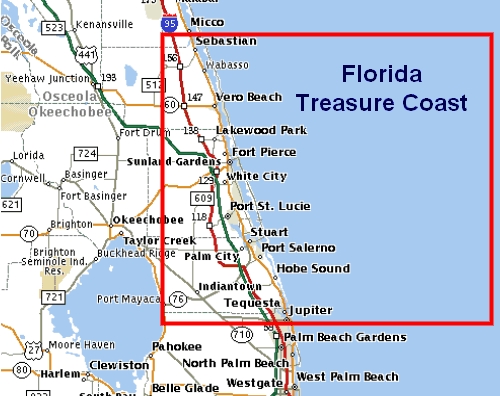A stretch of sand along Florida’s east coast is known as the Treasure Coast, where tranquil sands and a rich history await. In stark contrast to the faster pace just to the south, this area of Florida features a culturally vibrant, yet laid-back quality of life centered on beaches, boating, fishing, art, community and the outdoors. It is located on the state’s Atlantic coast, comprising the counties of Indian River, St Lucie, and Martin counties. How could you name this coast anything but the Treasure Coast? Over 300 years ago the “Spanish Treasure Fleet” was lost in a 1715 hurricane carrying gold and silver off the southeastern shore of Florida dumping their vast treasures into the ocean. The term was coined by John J. Schumann Jr. and Harry J. Schultz of the Vero Beach Journal newspaper shortly after salvagers began recovering Spanish treasure off the coast in 1961. The area has long been inhabited, but like other of Florida”s vernacular regions, a popular identity for the area did not emerge until the area saw its initial population boom in the 20th century. It is one of several “coast” regions in Florida, like the Gold Coast and the First Coast. In September 1696, a young Quaker merchant of Jamaica named Jonathan Dickinson was shipwrecked near the St. Lucie Inlet along with his family and other passengers and crew members. Dickinson encountered the local Ais Indians, a tribe that lived along the shores of the great lagoon called Rio de Ais by the Spanish, and now called the Indian River. All of the Treasure Coast is shielded from the Atlantic Ocean by narrow sanbars and barrier islands that protect the shallow lagoons, rivers, and bays. Immediately inland, pine and palmetto flatlands are abundant. Numerous lakes and rivers run through the Treasure Coast, notably the well known Indian River, a part of the Indian River Lagoon system.
The Treasure Coast includes two metropolitan statistical areas:
- The Port St. Lucie, Florida Metropolitan Statistical Area, consisting of Martin and St. Lucie counties. Port St. Lucie is designated as the principal city. The two-county metropolitan statistical area was first defined in 1983 as the Fort Pierce Metropolitan Statistical Area. In 1993, the MSA was renamed the Fort Pierce-Port St. Lucie Metropolitan Statistical Area. In 2006, Fort Pierce was dropped as a principal city and the name was changed to its present form.
- The Sebastian – Vero Beach, Florida Metropolitan Statistical Area, which is coextensive with Indian River County. Sebastian and Vero Beach are designated as the principal cities.

